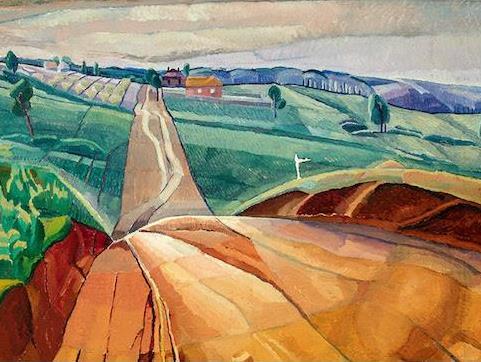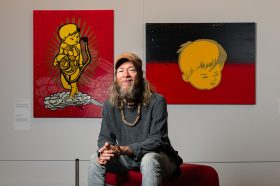Detail of Grace Cossington Smith’s Landscape at Pentecost, 1929; Art Gallery of South Australia, South Australian Government Grant 1981 © Estate of Grace Cossington Smith
Cody Hartley is used to getting phone calls at the Georgia O’Keeffe Museum from international curators wanting to take an O’Keeffe exhibition to bolster their visitor numbers through her blockbuster appeal.
But it was a call from Jason Smith, former Director of Heide Museum of Modern Art and QAGOMA Curatorial Manager of Australian Art, which caught his attention.
‘I thought, here we go again. But Jason surprised me. He said he wanted to bring O’Keeffe to Australia to show Australians how to better understand Australian Modernism,’ said Hartley.
‘I knew next to nothing about Australian Modernism, but I loved the idea of deepening and generating this international conversation with Modernism, and to think about O’Keeffe from another perspective was really exciting.’
The exhibition, O’Keeffe, Preston, Cossington Smith: Making Modernism, is showing at the Queensland Art Gallery (QAG) until 11 June.
It brings together 90 works by the iconic American painter Georgia O’Keeffe and pioneering Australian artists Margaret Preston and Grace Cossington Smith – three artists whose practice was coming of age in the 1920s and 30s, decades of great social change and transition.
Undeniably, there is a gender conversation to be had with this exhibition but Heide Curator Lesley Harding assured that it was ‘incidental’ to the curatorial process.
‘We didn’t choose Preston and Cossington Smith because they were women – they were great artists. When we went to the O’Keeffe Museum we presented about a dozen Australian artists who we felt spoke well with O’Keeffe’s work and made the same sort of contribution to art practice in their own country,’ she explained.
‘Some work looked more like O’Keeffe’s aesthetically, but ultimately it came down to distilling it to the same sort of independent approaches to Modernism.’
Hartley said that going through the Art Gallery of NSW’s collection of Margaret Prestons, he knew immediately that this show had to happen.
‘These three artists made contributions that didn’t emphasise their gender but encouraged people to look at their work from other positions,’ he explained.

Georgia O’Keeffe’s Blue Line, 1919; Georgia O’Keeffe Museum, Gift of The Burnett Foundation, © Georgia O’Keeffe Museum
How can the familiar still be radical?
The curatorium putting together this show included Smith, Hartley and Harding as well as Carolyn Kastner from the Georgia O’Keeffe Museum in Santa Fe (USA) and Denise Mimmocchi (AGNSW).
One of the challenges they faced was to convey some sense of how radical these works really were at the time of their making.
‘Their work is not aesthetically related, they did not know each other, but they came to the same realisations and similar motivations regarding European Modernism, then moved beyond that to make it relevant to their times and their locations,’ said Harding.
Visitors walk through parallel pairings of Preston and Cossington Smith’s works, which are hung chronologically in separate galleries, before they arrive at 30 works by O’Keeffe.
‘The viewer starts consolidating the threads, and we found that a much more compelling way of showing the work rather than trying to juxtapose an image of a river with an image of a river, for example. It didn’t seem right in the end to interrupt the flow of getting the gist of someone’s career,’ Harding said.
Among the works are iconic pieces never before seen in Australia: Georgia O’Keeffe’s Storm Cloud, Lake George (1923), The Black Iris (1926) and her skull and floral motif, Ram’s Head, Blue Morning Glory (1938).

Georgia O’Keeffe’s Ram’s Head, Blue Morning Glory, 1938; Georgia O’Keeffe Museum, Gift of The Burnett Foundation, © Georgia O’Keeffe Museum
‘Generations have grown up looking at these works – they are definitive of our national culture and speak about places we know and love. And yet, at their moment of creation, all of these works were really pioneering. These artists rejected their training and their teachers and wanted to find their own voice, their own subjects and that was so much a part of the Modern project,’ said Hartley.
Acting Curatorial Manager, Australian Art at QAGOMA, Kyla McFarlane, said: ‘Seeing them together in the flesh is just fantastic.’
She believes the show is timely. ‘There is real interest, particularly with young women artists and curators, in what they have achieved. These women were highly innovative, they travelled a lot and their significance in terms of what they did in the 20th century is still having an impact in the 21st in terms of what they achieved.
‘They turned the still life generation on its head; it was not genteel at all,’ she added.

Margaret Preston’s Implement blue, 1927; Art Gallery of New South Wales Gift of the artist 1960, © Margaret Rose Preston Estate Photo: AGNSW/Jenni Carter
Harding continued: ‘That’s what is so radical – they did experiment, and were not swayed by the critics or whether they sold their work. And despite being full time practitioners and having to earn a living, they forged ahead with their own language that they believed in!’
Today, O’Keeffe carries the world’s highest price for a woman artist, and in the last couple of years has more than tripled previous auction records. ‘She continues to hold the bar for visibility and influence for a female artist internationally,’ said Hartley.
‘Walking through the exhibition is a visual treat and an intellectual challenge to answer, “How did these women achieve this at that time?”. It becomes a laboratory for their experimentation,’ he added.
‘It is remarkable that they weren’t in dialogue – that they didn’t know each other.’
Hartley said that working with Australian curators bought a fresh perspective to understanding Georgia O’Keeffe and has helped him rethink how she approached her work.
On the flipside, McFarlane commented: ‘To bring O’Keeffe to Australia is one thing, but to notice these affinities across the world and their parallel careers and conversations with Modernism has not been talked about and it is incredibly inspiring.’
Catch O’Keeffe, Preston, Cossington Smith: Making Modernism at the Queensland Art Gallery, Brisbane, 11 March – 11 June. Ticketed.
This project is made possible through support from the Terra Foundation for American Art and is generously supported by the Art Gallery of New South Wales Society, the Gordon Darling Foundation and the Government of the United States.
Following its season at the Queensland Art Gallery, the exhibition will tour to the AGNSW.





